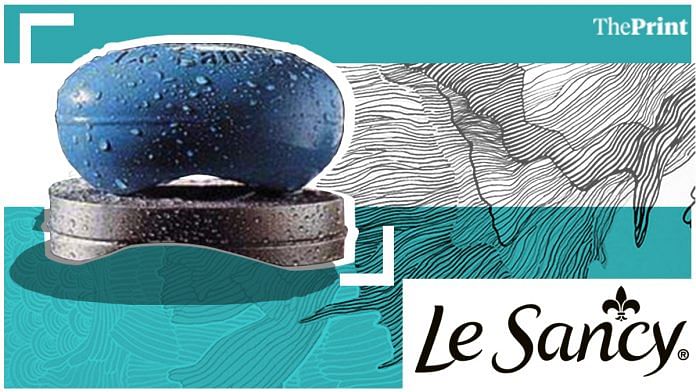New Delhi: Picture this: A kid, around 10 years old, dances to a popular song playing on a stereo in the bathroom. He turns the shower on, but instead of having a quick shower, he just continues to dance. Soon after, we hear a female voice — his mother— saying, “Rahul! Pani chala jayega!” (Rahul! The water will run out!) Oblivious to his mother’s annoyance, Rahul raises the volume and carries on dancing. As expected, the water runs out. His mother, exasperated, says, “Rahul! Kaha tha na paani chala jayega!” (Rahul! I told you the water would run out!)
Then a singsong boy’s voice, almost ubiquitous to ads in the 1990s, says, “Is duniya mein, jahan kuch nahin chalta, wahan shukr hai Le Sancy to hai” (In a world where nothing else lasts, thankfully there is Le Sancy).
The ad was a hit. Unfortunately, its tagline didn’t hold true, and Le Sancy pretty much disappeared from the Indian market in a few years.
Also read: ‘Man’s best friend’ — cult Czech classic bike Jawa is back because the brand never died
All lather, no substance
A product of Hindustan Unilever (then HLL), it was launched in India during the early ’90s, and soon caught the imagination of TV watchers.
“My name is Rahul and I am here just to recollect memories…back then everyone used to say ‘Rahul pani chala jayega”, reads a comment on the ad’s YouTube video. Another user wrote, “I was named Rahul after watching this ad”.
Writer-filmmaker Bhasker Vishwanathan recalls, “The soap had a unique round shape, which was one of the reasons for its initial popularity…we were thrilled to use it. It was quite a sensation. Friends used to compliment someone who used that soap saying “ye Le Sancy se nahata hai (he uses Le Sancy).”
Piyush Pandey, behind some of the most famous campaigns, including Doordarshan’s Mile Sur Mera Tumhara, the BJP’s Achhe Din campaign for the 2014 Lok Sabha elections and Amitabh Bacchan’s Gujarat tourism campaign, was the mastermind behind the iconic ad for Le Sancy.
“It was an interesting experience because the brand was launched in Chile in 1971. When it came to India in 1990, it already had a winning formula and advertising pattern. But India had changed, and so did the advertising market…” he says.
“Nothing is relevant all the time unless it has a soul, and we were able to find a way to put that soul into the ad,” Pandey adds.
He worked closely with director Harish Manwani, who later became the COO of Hindustan Unilever Limited, to craft strategies for the campaign.
The creative director of the ad, Sonal Dabral, recalls, “There were a few concerns in our mind before creating the ad — the name was unusual. We were worried whether Indian consumers would be able to remember the name. And that is how we came up with some funny print campaigns comparing it to other soaps — such as Le Sancy and Le Soggy, Le Sancy and Le Tiny. The print campaign was well received by international marketers also and they used it.” The ad became so popular that it won the Unilever chairman’s award that year.
The soap’s USP was its shape and its longevity. “It sought differentiation only on the basis of its boat shape, and its advertisers went out of their way to convince consumers that its shape would lead to a never-before bathing experience,” Prerna Trehan wrote in The Tribune.
The makers of the ad compared the supposedly long-lasting soap with things that were in scarce supply and should be conserved — which is how “Rahul! Pani chala jaayega!” was born.
“We take many things for granted in our country and water is one of them. We wanted to hit bullseye by comparing a soap that lasts with things that are relevant to us but don’t last,” Dabral says.
Also read: Mangola, a slurpy, happy feeling that wasn’t cool enough for Frooti & Pepsi generation
How the soap slipped in Indian market
Despite its much-hyped launch, the soap soon went off the shelves. “Because of its unique design, the soap had a different packaging, which used to get damaged during transportation. But it did well in the beginning as it held 30 per cent of the market share for the company,” says Pandey.
“Putting it in different packaging probably wasn’t a very good choice. The price was also changed, and it lost its charm. Things didn’t work out as expected,” he rues.
Jwngshar Narzary, a business professional, had another take. “This was another case of marketing myopia here. They considered what the consumer wanted, but the researchers forgot what the consumer needed,” he wrote.
In the wake of creating a less soggy and lasting bath product, the makers didn’t pay enough attention to the other essential features of the soap, he said. “When all the other soap brands were focusing on beauty, cleanliness, hygiene, health and wellness, the positioning of Le Sancy soap was very weak. It promised durability…but the offering was not at all appealing.”
What does remain, though, is a nostalgia for a simpler time. A time when, instead of blatant consumerism and capitalist greed, advertising, even for something like soap, focused on conservation.
Also read: Fauji: The show that launched a broody, chain-smoking SRK on the path to Bollywood glory






